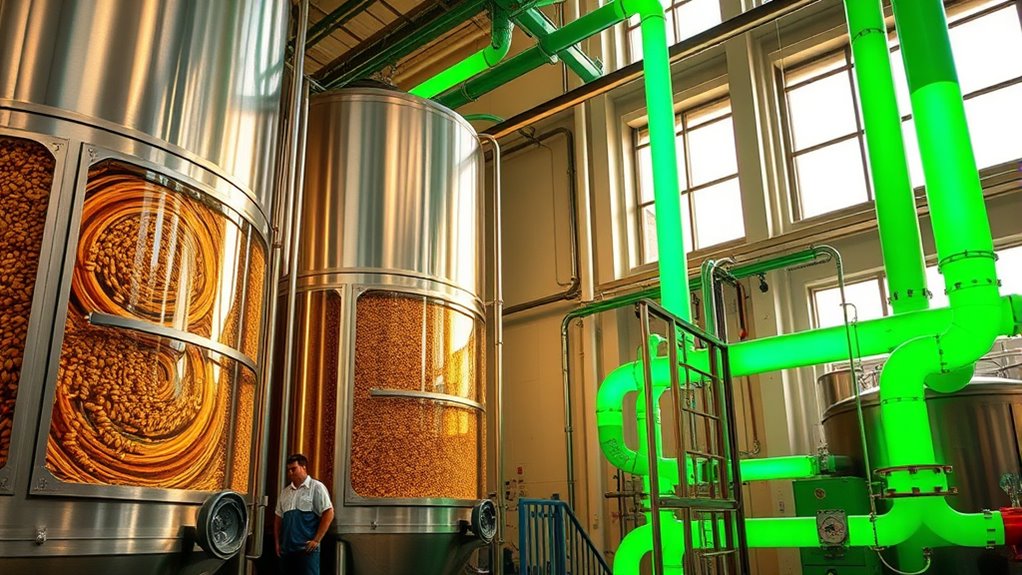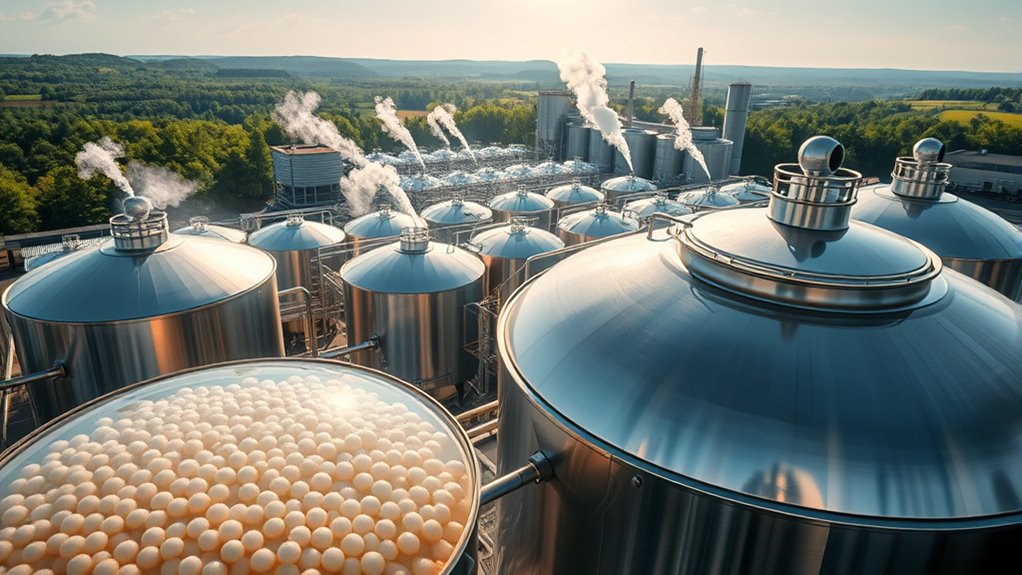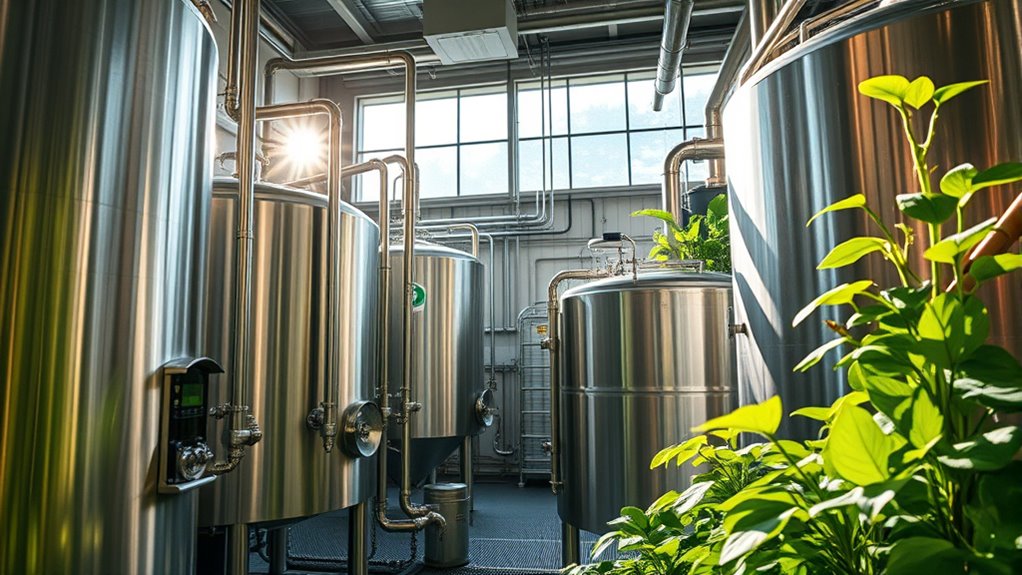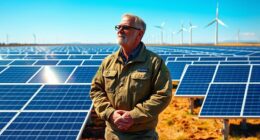You can turn beer waste into clean energy by using advanced anaerobic digestion systems like UASB or EcoVolt, which efficiently convert spent grains and wastewater into biogas. This biogas, with up to 90% methane, fuels power and heat systems, reducing reliance on external energy sources. Implementing these sustainable practices not only cuts costs but also boosts environmental benefits. Stay tuned to discover how these innovations are transforming breweries into eco-friendly powerhouses.
Key Takeaways
- Breweries convert spent grains into biogas through anaerobic digestion, generating renewable energy and reducing waste disposal costs.
- Advanced systems like EcoVolt require minimal space and energy, enabling scalable, sustainable waste-to-energy solutions for breweries.
- Biogas produced with up to 90% methane can be used in CHP systems or direct combustion to supply electricity and heat.
- Waste recovery practices transform residual solids into animal feed or ingredients, promoting circular economy principles.
- Implementing these green technologies enhances environmental sustainability and lowers operational costs for breweries.
Transforming Spent Grains Into Energy Gold

Transforming spent grains into energy gold is a smart way for breweries to reveal the hidden value in their waste. When you feed spent grains into anaerobic digesters, residual sugars and organic materials break down, producing methane gas—about 75 cubic meters per tonne. This process makes spent grains the most energy-rich brewing residue. Instead of discarding this waste, you can convert it into a renewable energy source, reducing reliance on external power. On-site biofuel systems allow you to recycle waste efficiently, lowering your electricity and heating costs. By harnessing anaerobic digestion, you turn what was once trash into a valuable asset—fuel that can power your brewery or be sold as green energy. This approach not only boosts sustainability but also adds economic value to your operations. Additionally, portable power sources can be used to support your biofuel systems, ensuring continuous operation even during power outages. Incorporating reliable backup power systems can help maintain operations during grid disruptions, safeguarding your investment in sustainable practices. Implementing energy storage solutions can further optimize energy use and enhance overall efficiency.
Cutting-Edge Anaerobic Digestion Technologies

Innovative anaerobic digestion systems now offer higher efficiency and smaller footprints for breweries. Technologies like EcoVolt require less space and energy, making them ideal for compact operations. By adopting these advanced methods, you can maximize waste-to-energy conversion while saving on treatment costs. Additionally, choosing reliable vendor services ensures consistent performance and minimizes operational risks. Incorporating environmentally friendly practices not only benefits the planet but can also improve your brewery’s reputation among eco-conscious consumers. Embracing sustainable waste management strategies further enhances your commitment to environmental responsibility and long-term operational resilience. Leveraging personal growth principles, such as visualization and goal alignment, can inspire your team to innovate and stay committed to sustainable practices. Utilizing advanced digestion technologies can also help breweries stay ahead of evolving regulations and industry standards.
High-Rate Digestion Efficiency
Have you ever wondered how breweries can maximize energy recovery from their waste? High-rate digestion technologies, like UASB and EGSB systems, are key. These advanced systems operate with very short hydraulic retention times—sometimes just 1 to 2 days—compared to traditional methods. This means they process waste quickly, reducing space and energy needs. They also achieve BOD reductions over 80%, making treatment more efficient. By maintaining high microbial activity, these systems generate biogas with 80 to 90 percent methane content, ideal for energy use. Innovations like Cambrian Innovation’s EcoVolt further enhance efficiency by requiring less energy for mixing and pumping. Additionally, process optimization can significantly improve the overall performance of high-rate digesters. Overall, high-rate digesters enable breweries to recover more energy from less waste, optimizing both environmental and economic benefits. Proper plant maintenance is essential for sustaining the performance and longevity of these high-rate digestion systems.
Compact Treatment Systems
Compact treatment systems are revolutionizing how breweries handle waste by offering efficient, space-saving anaerobic digestion solutions. These advanced systems require markedly less space than traditional setups—EcoVolt technology, for example, needs only 450 square feet compared to 3,000 square feet for conventional treatment. They operate with shorter hydraulic retention times, often just one to two days, reducing energy consumption for mixing and pumping. High-rate anaerobic digesters can achieve over 80 percent BOD reduction while producing biogas with 80 to 90 percent methane content. This biogas can be used directly in combined heat and power units or as a substitute for natural gas. Additionally, fraud detection techniques in transaction processing can be adapted to monitor system performance and prevent operational anomalies. Innovative monitoring methods can further enhance system efficiency and early fault detection. Implementing these systems also involves understanding system scalability, ensuring that the technology can grow with your operation. Incorporating real-time data analysis can help optimize biogas production and system maintenance. Moreover, integrating sustainable energy practices can improve overall environmental impact and reduce operational costs. These compact systems make on-site waste treatment more feasible, affordable, and scalable, empowering breweries to implement sustainable energy solutions without extensive space or infrastructure investments.
Harnessing Biogas for Power and Heat

You can convert biogas into electricity and heat through various methods like combined heat and power systems or direct combustion. This process offers significant energy output benefits, reducing reliance on external energy sources and lowering costs. Battery technologies play a crucial role in efficiently storing and managing the energy generated from biogas conversion. By harnessing biogas effectively, your brewery can turn waste into a valuable, sustainable power source. Additionally, implementing vertical storage solutions can optimize the handling and storage of waste materials involved in biogas production. Incorporating wall organization systems can further streamline the storage process, keeping the workspace tidy and efficient. Utilizing energy management systems can also help monitor and optimize energy use, ensuring maximum efficiency and sustainability.
Biogas Conversion Methods
How exactly can biogas be transformed into usable power and heat? You can use biogas in combined heat and power (CHP) systems, where methane-rich gas fuels turbines or engines to generate electricity. The heat produced during combustion can be captured and used for hot water or space heating, making your brewery more energy-efficient. Additionally, implementing energy recovery techniques can further optimize resource utilization and reduce waste. Incorporating sustainable practices can enhance your brewery’s environmental impact and community reputation. Alternatively, biogas can replace natural gas in boiler systems, providing thermal energy directly. You can also burn biogas in dedicated burners or flares to produce heat for processes like pasteurization or sterilization. These methods maximize the energy extracted from your brewery’s waste, creating a self-sustaining loop that reduces reliance on external power sources. Incorporating renewable energy strategies can also help your team innovate and stay motivated during the transition to renewable energy solutions. By integrating these conversion techniques, you turn waste into valuable, renewable energy, lowering costs and boosting your brewery’s sustainability.
Energy Output Benefits
Harnessing biogas for power and heat releases significant energy output benefits for breweries. It allows you to convert waste into valuable electricity and thermal energy, reducing reliance on external energy sources. Using biogas in combined heat and power (CHP) systems provides on-site electricity generation while capturing heat for brewing processes, lowering operational costs. Residual biogas can also replace natural gas in boilers, further cutting energy expenses. With high methane content—up to 90 percent—biogas offers a reliable renewable fuel source, boosting your sustainability profile. Additionally, converting waste to energy minimizes emissions and waste disposal costs. Understanding spiritual energy transfer can enhance your operation’s holistic sustainability approach by fostering a mindful connection to environmental impact. Overall, harnessing biogas enhances your brewery’s energy efficiency, supports environmental goals, and creates a more resilient, circular operation aligned with eco-friendly practices.
Wastewater and Solids: Sustainable Treatment Solutions

Effective wastewater and solids management is essential for sustainable brewing operations, as it minimizes environmental impact and reduces disposal costs. You can achieve this by separating solids from soluble waste using centrifugal systems or filtration processes like BKT’s FMX. Recovered solids, including spent grains, can be repurposed as animal feed or raw materials for food products, eliminating disposal fees. Soluble waste is ideal for high-rate anaerobic digestion, which converts organic matter into biogas for energy generation. Technologies like UASB and EcoVolt systems enable efficient treatment with minimal energy use and space requirements. By integrating these methods, your brewery can produce renewable energy, lower waste disposal costs, and promote a circular economy—making your operations both eco-friendly and economically sustainable.
Embracing Circular Economy for Breweries

Embracing a circular economy allows breweries to transform waste into valuable resources, reducing environmental impact and boosting profitability. You can repurpose spent grains, converting them into high-protein ingredients for food products like bread and snacks, creating new revenue streams. On-site biofuel systems enable you to recycle waste into renewable energy, lowering energy costs and dependence on external sources. Implementing anaerobic digestion and solids separation technologies helps you efficiently process wastewater and residual solids, producing biogas and reusable water. These practices not only minimize waste disposal expenses but also promote sustainability, appealing to eco-conscious consumers. Collaborations with research institutions and energy providers can further optimize waste-to-energy processes, ensuring your brewery remains innovative and environmentally responsible. Embracing this approach solidifies your role in a sustainable, circular brewing industry.
Pioneering Research and Future Innovation in Brewing Energy

Advances in brewing energy research are opening new pathways for turning waste into valuable renewable resources. You can now harness innovative anaerobic digestion technologies, like EcoVolt, which require less space and energy while producing high-quality biogas with 80-90% methane content. Researchers are exploring ways to convert brewery waste into biofuels by combining wastewater with kelp, fish waste, or seaweed, expanding options for sustainable energy. Partnerships between universities, breweries, and engineering firms are accelerating these developments, making it possible to generate 1,200 to 50,000 tons of organic waste annually into two to three megawatts of energy. These innovations not only reduce waste and emissions but also create scalable solutions for breweries of all sizes, moving the industry toward a more sustainable, circular future.
Frequently Asked Questions
How Much Energy Can a Brewery Generate Annually From Its Waste?
You can generate between 2 to 3 megawatts of energy annually from your brewery waste, depending on the size and efficiency of your biofuel systems. By converting spent grains and wastewater through anaerobic digestion and biogas utilization, you’ll produce enough renewable energy to power your operations, reduce costs, and lower your environmental impact. Scaling up or adopting advanced technologies can further increase your brewery’s energy output from waste.
What Are the Costs Associated With Installing Anaerobic Digestion Systems?
Installing anaerobic digestion systems costs vary, but imagine transforming waste into renewable energy without breaking the bank. Small-scale setups can start around $100,000, while larger, high-rate systems like EcoVolt might reach $500,000 or more. You’ll also face expenses for site prep, equipment, and ongoing maintenance. Though initial costs seem high, the energy savings and environmental benefits help offset these investments over time, making it a smart, sustainable choice.
Can Small Breweries Effectively Implement Biogas Recovery Technologies?
Yes, small breweries can effectively implement biogas recovery technologies. With compact systems like EcoVolt needing only 450 square feet and requiring less energy, you can convert waste into renewable energy efficiently. These systems reduce waste disposal costs, cut energy expenses, and support sustainability goals. Partnering with technology providers or research projects makes adoption easier and more affordable, helping small breweries turn waste into valuable resources without major disruptions.
How Does Waste Pretreatment Affect Biogas Production Efficiency?
Waste pretreatment considerably boosts biogas production efficiency, increasing yields by up to 20-30%. When you pre-treat waste, you’re breaking down residual sugars and organic matter more effectively, making it easier for anaerobic digesters to produce methane. This process reduces the time needed for digestion, improves biogas quality, and maximizes energy output. Essentially, proper pretreatment transforms waste into a powerful renewable energy resource, saving costs and reducing environmental impact.
What Are the Biggest Challenges in Scaling Brewery Waste-To-Energy Projects?
You’ll face challenges like high upfront costs for equipment and infrastructure, which can deter investment. Additionally, integrating waste-to-energy systems into existing brewery operations requires technical expertise and space, often limiting scalability. Regulatory hurdles and inconsistent waste supply also pose problems. To overcome these, prioritize partnerships, seek funding opportunities, and develop flexible, modular systems that adapt to your brewery’s size and waste generation, making expansion more feasible.
Conclusion
As you see, this brewery’s innovative approach turns what once was waste into a source of clean energy, proving that sustainability and success can go hand in hand. It’s a coincidence how something as simple as spent grains can spark a revolution in green brewing. By embracing these technologies, you’re not just making beer—you’re creating a future where waste fuels progress. Together, we’re brewing a cleaner, brighter world—one sip at a time.









